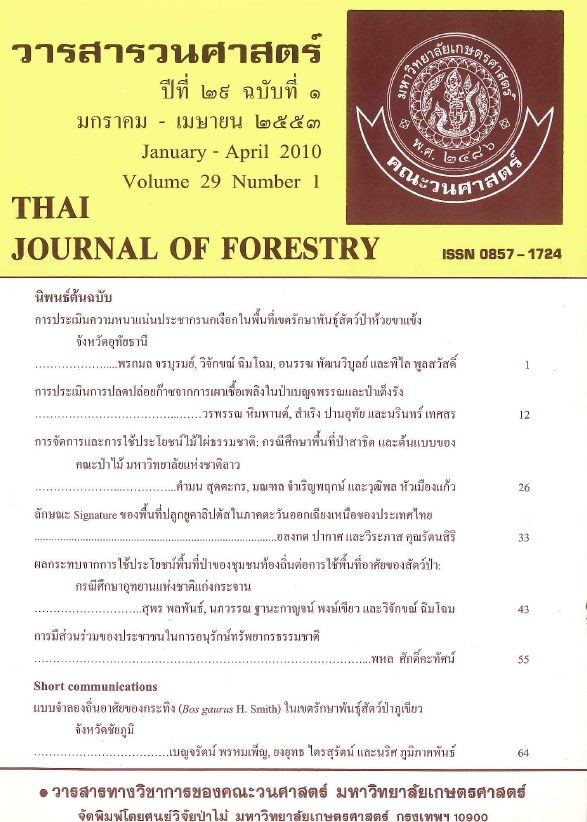ผลกระทบจากการใช้ประโยชน์พื้นที่ป่าของชุมชนท้องถิ่น ต่อการใช้พื้นที่อาศัยของสัตว์ป่า: กรณีศึกษาอุทยานแห่งชาติแก่งกระจาน
Main Article Content
บทคัดย่อ
การวิจัยมีวัตถุประสงค์เพื่อศึกษาการใช้ประโยชน์พื้นที่ป่าของชุมชนท้องถิ่น และศึกษาลักษณะการใช้พื้นที่อาศัยของสัตว์ป่า รวมถึงทำการวิเคราะห์ผลกระทบของการใช้ประโยชน์พื้นที่ป่าของชุมชนต่อการใช้พื้นที่ของสัตว์ป่าในเขตอุทยานแห่งชาติแก่งกระจาน ใช้แบบสอบถามเก็บข้อมูล จำนวน 202 ชุด วางแนวเส้นตรง 6 เส้น รวม 69 กิโลเมตร สำรวจร่องรอยสัตว์ป่า 5 ชนิด คือ กระทิง เก้ง กวาง หมูป่า และช้างป่า ใช้สถิติ Mann-Whitney U Test และ การวิเคราะห์สหสัมพันธ์ ในการวิเคราะห์ข้อมูลและสรุปผลการศึกษา พบว่า ราษฎรส่วนใหญ่ร้อยละ 69.3 ยังเก็บหาของป่า โดยเข้าไปเก็บหาในเขตอุทยานฯ ร้อยละ 50.5 เก็บเห็ดมากที่สุดร้อยละ 50.0 รองลงมาคือ ผักหวาน และหน่อไม้ร้อยละ 39.1 และ 33.2 ตามลำดับ ระยะทางห่างจากหมู่บ้านเฉลี่ย 2.23 กิโลเมตร ใช้เวลาเฉลี่ยในการเก็บหา 1.36 ชั่วโมง/วัน เดือนตุลาคมเก็บหามากที่สุด ราษฎรส่วนใหญ่เข้าใจผลกระทบการใช้พื้นที่ป่าต่อสัตว์ป่า แต่คิดว่าการเก็บหาของป่ายังมีความจำเป็นต่อการยังชีพ ส่วนการศึกษาด้านสัตว์ป่า พบว่า ฤดูฝนปรากฏร่องรอยของสัตว์ป่า 136.58 รอย/กิโลเมตร ฤดูแล้งปรากฏร่องรอย 102.93 รอย/กิโลเมตร การใช้พื้นที่ของสัตว์ป่าในป่าที่ใช้ประโยชน์เข้มข้นกับเบาบาง มีค่าเฉลี่ยของร่องรอยในพื้นที่ใช้ประโยชน์เข้มข้น (=32.97) น้อยกว่าพื้นที่ใช้เบาบาง (=86.78) และมีความแตกต่างกันอย่างมีนัยสำคัญทางสถิติ ในแต่ละชนิดพันธุ์ดังนี้ คือ กระทิง ค่า U=231571.5; p=0.001 กวาง ค่า U= 214804.50; p=0.000 เก้ง ค่า U=224404.00; p =0.000 หมูป่า ค่า U=233929.5; p=0.000 และ ช้างป่า ค่า U=243894.0; p=0.008 เมื่อทดสอบความสัมพันธ์ พบว่า ระยะทางมีความสัมพันธ์กับการพบร่องรอย กระทิง กวาง และเก้ง อย่างมีนัยสำคัญทางสถิติ เท่ากับ 0.221 0.439 และ 0.384 ตามลำดับ ซึ่งพบว่าเมื่อระยะห่างจากหมู่บ้านเพิ่มขึ้นค่าเฉลี่ยการปรากฏของร่องรอยจะเพิ่มมากขึ้นสรุปได้ว่ากิจกรรมการใช้ประโยชน์พื้นที่ป่าของชุมชนท้องถิ่น อาจจะมีผลกระทบทางลบต่อการใช้พื้นที่ของสัตว์ป่า
คำสำคัญ: ผลกระทบจากการใช้พื้นที่ป่า ชุมชนท้องถิ่น สัตว์ป่า อุทยานแห่งชาติแก่งกระจาน
Downloads
Article Details

อนุญาตภายใต้เงื่อนไข Creative Commons Attribution-NonCommercial-NoDerivatives 4.0 International License.
ข้าพเจ้าและผู้เขียนร่วม (ถ้ามี) ขอรับรองว่า ต้นฉบับที่เสนอมานี้ยังไม่เคยได้รับการตีพิมพ์และไม่ได้อยู่ในระหว่างกระบวนการพิจารณาตีพิมพ์ลงในวารสารหรือสิ่งตีพิมพ์อื่นใด ข้าพเจ้าและผู้เขียนร่วม (ถ้ามี) ยอมรับหลักเกณฑ์และเงื่อนไขการพิจารณาต้นฉบับ ทั้งยินยอมให้กองบรรณาธิการมีสิทธิ์พิจารณาและตรวจแก้ต้นฉบับได้ตามที่เห็นสมควร พร้อมนี้ขอมอบลิขสิทธิ์ผลงานที่ได้รับการตีพิมพ์ให้แก่วารสารวนศาสตร์ คณะวนศาสตร์ มหาวิทยาลัยเกษตรศาสตร์ กรณีมีการฟ้องร้องเรื่องการละเมิดลิขสิทธิ์เกี่ยวกับภาพ กราฟ ข้อความส่วนใดส่วนหนึ่ง หรือ ข้อคิดเห็นที่ปรากฏในผลงาน ให้เป็นความรับผิดชอบของข้าพเจ้าและผู้เขียนร่วม (ถ้ามี) แต่เพียงฝ่ายเดียว และหากข้าพเจ้าและผู้เขียนร่วม (ถ้ามี) ประสงค์ถอนบทความในระหว่างกระบวนการพิจารณาของทางวารสาร ข้าพเจ้าและผู้เขียนร่วม (ถ้ามี) ยินดีรับผิดชอบค่าใช้จ่ายทั้งหมดที่เกิดขึ้นในกระบวนการพิจารณาบทความนั้น”


